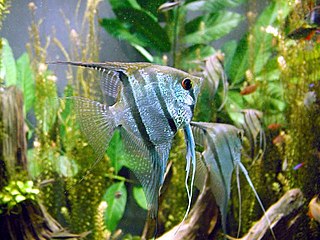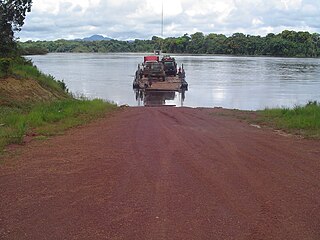
Lake Tanganyika is an African Great Lake. It is the second oldest freshwater lake in the world, the second largest by volume, and the second deepest, in all cases after Lake Baikal in Siberia. It is the world's longest freshwater lake. The lake is divided among four countries – Tanzania, Democratic Republic of the Congo (DRC), Burundi, and Zambia, with Tanzania (46%) and DRC (40%) possessing the majority of the lake. The water flows into the Congo River system and ultimately into the Atlantic Ocean.
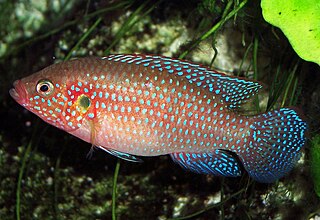
Hemichromis is a genus of fishes from the cichlid family, known in the aquarium trade as jewel cichlids. Jewel cichlids are native to Africa. Within West Africa, Hemichromis species are found in creeks, streams, rivers and lakes with a variety of water qualities including brackish water lagoons.

Geophagus is a genus of cichlids that mainly live in South America as far south as Argentina and Uruguay, but a single species, G. crassilabris is from Panama. They are found in a wide range of freshwater habitats. They are part of a group popularly known as eartheaters and mostly feed by picking up mouthfuls of sand to sift out food items such as invertebrates, plant material and detritus. The largest species reach up to 28 cm (11 in) in standard length. They are often kept in aquariums.

Biotodoma is a small genus of cichlids native to rivers in the Amazon, Orinoco and Essequibo basins in South America.
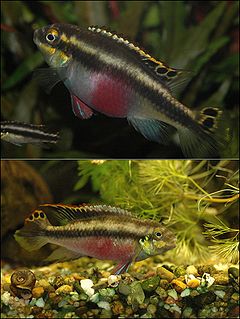
Pelvicachromis pulcher is a freshwater fish of the cichlid family, endemic to Nigeria and Cameroon. The species is popular amongst aquarium hobbyists, and is most commonly sold under the name kribensis, although the species has other common names, including various derivatives and color morphs of the kribensis: krib, common krib, red krib, super-red krib and rainbow krib, along with rainbow cichlid and purple cichlid. The species is a popular cichlid for the aquarium.

Diplotaxodon is a small genus of seven formally described, as well as a number of undescribed, deep-water species of cichlid fish endemic to Lake Malawi in east Africa. These fishes represent a remarkable adaptive radiation of offshore and deep-water adapted fish descended from ancestral shallow water forms. They include the dominant zooplankton-feeding fish of the offshore and deep-water regions of the lake, as well as a number of larger species that appear to feed on small pelagic fishes. Adult sizes range from 10 to 30 cm in total length, depending on species.

Neolamprologus multifasciatus is one of the small shell-dwelling cichlids endemic to Lake Tanganyika. The male reaches 5 cm (2 in) in length, and the female only 2.5 cm (1 in). This makes them one of the smallest cichlid species in the world. Its natural habitat is the Neothauma shell beds of Lake Tanganyika, where it forms huge colonies with thousands of individuals. Their unique behavior is associated with their affinity to shells. They burrow sand to move shells, take refuge in shells and also breed in them. They have pale white coloring with black vertical bars running the length of their bodies. The species is sexually monomorphic, meaning sexing individuals is extremely hard or impossible based on external appearance alone.

Rhamphochromis is a genus of East African haplochromine cichlids endemic to the Lake Malawi basin, including the main lake, Lake Malombe, Lake Chilingali, Chia Lagoon and upper Shire River. They mainly occur in offshore open waters, but a few species also near the coast. They are piscivores that typically feed on lake sardines and small utaka cichlids.
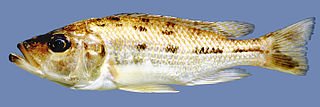
Hemitaeniochromis urotaenia is a species of fish endemic to Lake Malawi in East Africa. It is the type species of the genus Hemitaeniochromis, and is part of family Cichlidae in subfamily Pseudocrenilabrinae and the tribe Haplochromini.

Copadichromis borleyi is a species of haplochromine cichlid fish endemic to Lake Malawi in East Africa. The species is popular in the fishkeeping hobby where it is frequently kept in aquariums. The species has numerous common names, including redfin hap and goldfin hap.

Apistogramma nijsseni is a species of cichlid fish, endemic to highly restricted local black water habitats in the Quebrada Carahuayte, a small stream in the Ucayali River drainage, southern Peru. The male reaches a maximum length of 8 cm (3 in), the female remaining somewhat smaller. Apistogramma brooding females assume a bright yellow and black aposematic coloring: in A. nijsseni, unusually, a healthy, unstressed female retains this coloring. The species is popular aquarium fish amongst dwarf cichlid hobbyists, though it does not often appear in the general pet fish market.

The flavescent peacock, also known as Grant's peacock, is a species of haplochromine cichlid. Its common name refers to its "flavescent" (yellowish) colour.

The green chromide is a species of Cichlid fish from freshwater and brackish water in southern India and Sri Lanka. Other common names include pearlspot cichlid, banded pearlspot, and striped chromide. In Kerala in India it is known locally as the Karimeen. In Goa the fish is known as Kalundar In Sri Lanka this fish is known as Koraliya

The three spot cichlid, also known as the trimac or red-eyed cichlid, is a species of cichlid, from the subfamily Cichlasomatinae which are found in South America. It is a rarely found as an aquarium fish.
Herichthys deppii, also known as the Nautla cichlid, is a species of cichlid native to the Nautla and Misantla rivers of Mexico. It reaches a maximum size of 12 centimetres (4.7 in) TL. The specific name honours the German naturalist, explorer and painter, who collected type Ferdinand Deppe (1794-1861) who collected the type.

Geophagus is a tribe of cichlids from the subfamily Cichlinae, the American cichlids. It is the sister taxon to the clade which includes the Cichlasomatini and Heroini. Fishes in the Geophagini are distributed from Panama south to Argentina, it is the most speciose of the seven tribes within the Cichlinae and it is subdivided into three sub-tribes, Acarichthyina, Crenicaratina, and Geophagina which together contain over 200 species. Geophagines show morphological and behavioural specialisations to enable them to sift the substrates within their mouths so that they can separate benthic invertebrates from substrates dominated by sand or silt.
Biotodoma wavrini, the Orinoco eartheater, is a species of cichlid in the tribe Geophagini, part of the American cichlid subfamily Cichlinae. It is found in the middle and upper Rio Negro drainage in Brazil and Venezuela, and in the Orinoco River basin in Colombia and Venezuela. Its specific name honours the Belgian aristocrat, ethnologist and explorer Marquis Robert de Wavrin de Villers-au-Tertre (1888–1971), who collected the type specimen in 1935.

Astatotilapia calliptera, the Eastern happy or Eastern river bream, is a species of haplochromine cichlid from southern Africa.

